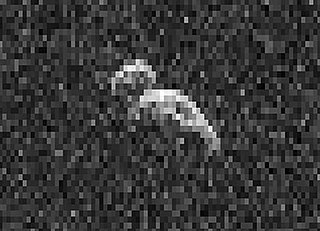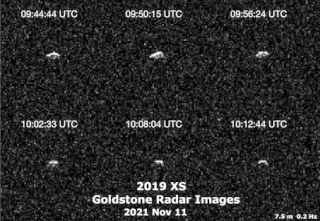Related Research Articles

A near-Earth object (NEO) is any small Solar System body whose orbit brings it into proximity with Earth. By convention, a Solar System body is a NEO if its closest approach to the Sun (perihelion) is less than 1.3 astronomical units (AU). If a NEO's orbit crosses the Earth's orbit, and the object is larger than 140 meters (460 ft) across, it is considered a potentially hazardous object (PHO). Most known PHOs and NEOs are asteroids, but a small fraction are comets.
(35396) 1997 XF11, provisional designation 1997 XF11, is a kilometer-sized asteroid, classified as a near-Earth object, Mars-crosser and potentially hazardous asteroid of the Apollo group.
The Minor Planet Center (MPC) is the official body for observing and reporting on minor planets under the auspices of the International Astronomical Union (IAU). Founded in 1947, it operates at the Smithsonian Astrophysical Observatory.
Brian Geoffrey Marsden was a British astronomer and the longtime director of the Minor Planet Center (MPC) at the Center for Astrophysics | Harvard & Smithsonian.

Lowell Observatory Near-Earth-Object Search (LONEOS) was a project designed to discover asteroids and comets that orbit near the Earth. The project, funded by NASA, was directed by astronomer Ted Bowell of Lowell Observatory in Flagstaff, Arizona. The LONEOS project began in 1993 and ran until the end of February 2008.

The Spacewatch Project is an astronomical survey that specializes in the study of minor planets, including various types of asteroids and comets at University of Arizona telescopes on Kitt Peak near Tucson, Arizona, in the United States. The Spacewatch Project has been active longer than any other similar currently active programs.
The OCA–DLR Asteroid Survey (ODAS) was an astronomical survey to search for small Solar System bodies focusing on near-Earth objects in the late 1990s. This European scientific project was a collaboration between the French Observatoire de la Côte d'Azur (OCA) and the German Aerospace Center (DLR). The survey is credited for the discovery of one comet and more than 1000 minor planets during 1996–1999.

2062 Aten, provisional designation 1976 AA, is a stony sub-kilometer asteroid and namesake of the Aten asteroids, a subgroup of near-Earth objects. The asteroid was named after Aten from Egyptian mythology.
James Whitney Young is an American astronomer who worked in the field of asteroid research. After nearly 47 years with the Jet Propulsion Laboratory at their Table Mountain Facility, Young retired July 16, 2009.

A minor planet is "lost" when today's observers cannot find it, because its location is too uncertain to target observations. This happens if the orbital elements of a minor planet are not known accurately enough, typically because the observation arc for the object is too short, or too few observations were made before the object became unobservable.

276P/Vorobjov is a Jupiter-family comet discovered on 15 October 2012 by Tomáš Vorobjov on three 120-s images taken remotely using the 0.81-m f/7 Ritchey-Chretien Schulman Telescope located at the Mt. Lemmon SkyCenter via the Sierra Stars Observatory Network in the course of a minor-planet search survey undertaken as part of the International Astronomical Search Collaboration (IASC) school campaigns. After posting on the Minor Planet Center's NEOCP webpage, other observers have commented on the object's cometary appearance. The discovery was announced by the Minor Planet Center on 18 October, three days after the discovery.

The Sormano Astronomical Observatory is an astronomical observatory north of Milan, Italy. Located near the Swiss border at 1000 meters elevation at the mountain village of Sormano in the pre-Alps, the observatory was privately funded by the Gruppo Astrofili Brianza and built in 1986.
Dmitry Nikolayevich Chestnov is a Russian astronomer, observer and photometrist of comets and discoverer of minor planets. He lives in Saransk, the capital city of the Republic of Mordovia, Russia.
In planetary science, the term unusual minor planet, or unusual object, is used for a minor planet that possesses an unusual physical or orbital characteristic. For the Minor Planet Center (MPC), which operates under the auspices of the International Astronomical Union, any non-classical main-belt asteroid, which account for the vast majority of all minor planets, is an unusual minor planet. These include the near-Earth objects and Trojans as well as the distant minor planets such as centaurs and trans-Neptunian objects. In a narrower sense, the term is used for a group of bodies – including main-belt asteroids, Mars-crossers, centaurs and otherwise non-classifiable minor planets – that show a high orbital eccentricity, typically above 0.5 and/or a perihelion of less than 6 AU. Similarly, an unusual asteroid (UA) is an inner Solar System object with a high eccentricity and/or inclination but with a perihelion larger than 1.3 AU, which does exclude the near-Earth objects.

2020 BX12 is a sub-kilometer binary asteroid, classified as a near-Earth asteroid and potentially hazardous object of the Apollo group. It was discovered on 27 January 2020 by the Asteroid Terrestrial-impact Last Alert System survey at the Mauna Loa Observatory during its approach to Earth of 0.02915 AU (4.361 million km; 11.34 LD). Radar observations of the asteroid were carried out by the Arecibo Observatory on 4 February 2020, revealing a natural satellite orbiting 360 m (1,180 ft) from the primary body.
2021 AV7 is a near-Earth asteroid of the Apollo group, discovered by astronomers Alain Maury and G. Attard at San Pedro de Atacama, Chile on 15 January 2021. With an estimated diameter of 450–1,000 m (1,480–3,280 ft), it is considered a potentially hazardous asteroid. It has a highly elliptical orbit that brings it within Earth's orbit. Although its nominal orbit has a small minimum orbit intersection distance around 70,000 km (43,000 mi) from Earth's orbital path, the asteroid does not make any close approaches within 0.2 astronomical units (30×106 km; 19×106 mi) over the next 100 years.
2020 SL1 is a near-Earth asteroid of the Apollo group, discovered by the Pan-STARRS 1 survey at Haleakala Observatory, Hawaii on 18 September 2020. With an estimated diameter of 0.9–2.0 km (0.56–1.24 mi), it is the largest potentially hazardous asteroid discovered in 2020.
2020 SW is a tiny near-Earth asteroid discovered by the Mount Lemmon Survey on 18 September 2020, six days before it made its closest approach to Earth. The asteroid passed within 21,600 kilometres (13,400 mi) from Earth's surface on 24 September 2020 11:13 UT, within the geostationary altitude of 36,000 kilometres (22,000 mi). The encounter with Earth perturbed the asteroid's heliocentric trajectory from an Apollo-type orbit to an Aten-type orbit with a semi-major axis within one astronomical unit from the Sun. As a result, the asteroid will not make any close approaches to Earth within 0.01 astronomical units (4 LD) in the next 200 years.

2019 XS is a small Apollo near-Earth asteroid discovered on 2 December 2019 by the Mount Lemmon Survey in Arizona, United States. It passed 1.493 lunar distances from Earth on 9 November 2021 at 03:48 UTC, after which observations were checked by the International Asteroid Warning Network for timing and astrometric accuracy. During the close pass, the asteroid trailed across the far Southern Hemisphere to the Northern Hemisphere and reached a peak apparent magnitude of 13. A total of 957 observations were collected by Minor Planet Center as part of the International Asteroid Warning Network's campaign.
References
- 1 2 "Comments and Notes on the NEOCP". Minor Planet Center. Retrieved 14 August 2022.
- ↑ Marsden, B. G.; Williams, G. V. (February 1998). "The NEO confirmation page". Planetary and Space Science. 46 (2): 299–302. Bibcode:1998P&SS...46..299M. doi:10.1016/S0032-0633(96)00153-5.
- ↑ Marsden, Brian G. (January 2004). "Comets and asteroids: searches and scares". Advances in Space Research. 33 (9): 1514–1523. Bibcode:2004AdSpR..33.1514M. doi:10.1016/S0273-1177(03)00455-1.
- 1 2 "Guide to Minor Body Astrometry". Minor Planet Center. 9 November 2018. Retrieved 14 August 2022.
- ↑ "Isolated Tracklet File". Minor Planet Center. 22 October 2015. Retrieved 14 August 2022.
- ↑ Vereš, Peter; Payne, Matthew J.; Holman, Matthew J.; Farnocchia, Davide; Williams, Gareth V.; Keys, Sonia; Boardman, Ian (July 2018). "Unconfirmed Near-Earth Objects". The Astronomical Journal. 156 (1): 15. arXiv: 1805.02804 . Bibcode:2018AJ....156....5V. doi: 10.3847/1538-3881/aac37d . 5.
- ↑ Weryk, Robert; Wainscoat, Richard; Vereš, Peter (April 2021). NEOs in the Isolated Tracklet File. 7th IAA Planetary Defense Conference. Vienna, Austria. p. 10. Bibcode:2021plde.confE..32W. 32.